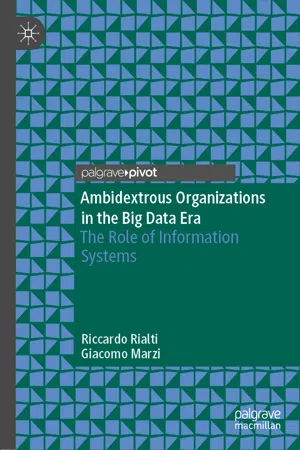“Big Data” is a current buzz word, often with different meanings and more often without a clear understating of what big data is. In this book, we try to propose a wide spectrum overview of what “Big Data” means for organizations and their managers through the work done by the authors in this field.
This book is the result of past researches, ongoing research projects that are published (or submitted for publishing) in leading academic journals, and maturated expertise gained over the years by the authors. The book is a comprehensive review, and it gives several results and insights that are the outcome of researches and studies in a format that is easy to understand by managers, practitioners, students, and other non-technical/academic audiences. The empirical results presented in the book are, therefore, based on real-world data and validated with the maximum academic rigor required by scientific publications.
Moving from this premise, an attempt is made to understand how an organization can benefit from the use of big data? In order to receive a benefit from the huge amount of information (big data), the first step is to control and regulate the flow of information. Effective management of the information inflow in an organization could only be achieved by an efficient Information System (IS), which is capable of organizing, storing and delivering the right information at the right time. It is important to perceive that to receive benefits from big data; Information Systems should be controlled and not be controlled by big data.
However, which benefits an organization could receive from big data is determined by several factors. The management of this huge amount of information has a cost, therefore, the benefits must be clear. One of the major benefits that an organization could receive from an effective big data management is the ability to develop an ambidextrous approach to the market, which is the topic of the present book.
An organization could be defined ambidextrous when it is able to exploit the current market opportunities while at the same time exploring new opportunities. The currently exploited opportunities were the explored opportunities of yesterday and the explored opportunities of today will become the opportunities to be exploited tomorrow (Kriz, Voola, & Yuksel, 2014). In order to be able to pursue this unceasing process of renovations, the organization needs a constant and well-managed flow of information, the big data.
In order to accomplish the objective of the book, a top-down approach has been followed from the academic literature to the voice of managers and practitioners.
In Chapter 2, the concept of Big Data, Dynamic Capabilities, and Ambidexterity is introduced by presenting the latest researches available on these topics. While doing so, it is also shown how big data is strongly connected with the strategies followed by the organization and how its role has been constantly recognized as a key success factor for modern organizations.
Chapter 3 explores the theoretical and managerial connection between big data, ambidexterity, and an organization’s agility. This chapter highlights an empirical process to find how and to what extent big data can influence an organization’s characteristics. In particular, the market and operation agility have been considered for this purpose. It has been shown that the correct use of big data can positively influence these two crucial aspects of the organization (Constantiou & Kallinikos, 2015).
In Chapter 4, a purely empirical approach is presented, where it is shown how managers can reach strategic agility through the use of big data. The empirical validation and confirmation of the concepts and best practices as presented in the two previous chapters are also explained. It also offers some additional insight into managerial practices in implementing big data (Dezi, Santoro, Gabteni, & Pellicelli, 2018; Mardi, Arief, Furinto, & Kumaradjaja, 2018). Chapter 4 explores the micro-linkages that exist between Big Data Analytics (BDA) capabilities to get agility through BDA and ambidexterity. Some empirical evidence from managers’ experiences of large European organizations is analyzed using multiple regressions approach to test the developed model. The analysis of results indicates that BDA capabilities play a significant role in an organization’s strategic agility.
The present book ends with inferences and a summary of the managerial perspective on how big data can influence the organization’s strategy, operational capability, and performance.
Finally, if a reader wants to delve into the academic literature behind the present book, the use of references given at the end of each chapter and cited throughout will permit a deeper exploration of the topics presented in the book for further research and applications.
Authors hope that the audience of this book can find the present text interesting and helpful in developing an efficient and effective managerial practice of big data in their everyday activities.
References
- Constantiou, I. D., & Kallinikos, J. (2015). New games, new rules: Big data and the changing context of strategy. Journal of Information Technology, 30(1), 44–57.Crossref
- Dezi, L., Santoro, G., Gabteni, H., & Pellicelli, A. C. (2018). The role of big data in shaping ambidextrous business process management: Case studies from the service industry. Business Process Management Journal, 24(5), 1163–1175.Crossref
- Kriz, A., Voola, R., & Yuksel, U. (2014). The dynamic capability of ambidexterity in hypercompetition: Qualitative insights. Journal of Strategic Marketing, 22(4), 287–299.Crossref
- Mardi, M., Arief, M., Furinto, A., & Kumaradjaja, R. (2018). Sustaining organizational performance through organizational ambidexterity by adapting social technology. Journal of the Knowledge Economy, 9(3), 1049–1066.Crossref
